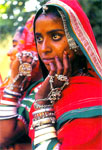| Costumes
 Rajasthani
turbans vary in style from region to region and caste and caste. Rajasthani
turbans vary in style from region to region and caste and caste.
Generally
speaking, the safa style is favoured by the Rajputs and the pagari by
business men. In Marwar, high turbans are used and the same style is found
in Sirohi and Jaisalimer. Bikaner has a special type known as the 'Khirkia
pag'. In the Udaipur region, the style is called Mewari. The buttoned-up
short coat is the official dress in Rajasthani courts. The women wear
colourful skirt and choli. Purdah is almost unknown in rural Rajasthan.
However, daughters-in-law draw a veil over their faces before elders.
In cities, the purdah system has been common among the higher castes,
the Rajputs and the Oswal Jains.Rajputs sport long and hairy moustaches
as the sign of their chivalry. They also have long 'kanpatis' and hair
on the head.
Surrounded by a fence of thorns and stacks of chaff the Rajastjani village
is like a small fort. But the huts do not have a uniform shape. The huts
are built with locally available material. Mud mixed with dry grass is
commonly used for walls and there is thatched roof made of bamboo, grass
and twigs. Some houses have roofs made of tiles or unbaked tricks. In
Mewar and Bundi, tribals build their houses with wood. In Marwar, the
hut is circular and the roof is conical. A pox inside supports the apex.
An annexe of the same material called a dogla is used as a cattle shed,
fodder-shed and store. The floors of the huts are painted deep red and
doors have folk designs and motifs. |

